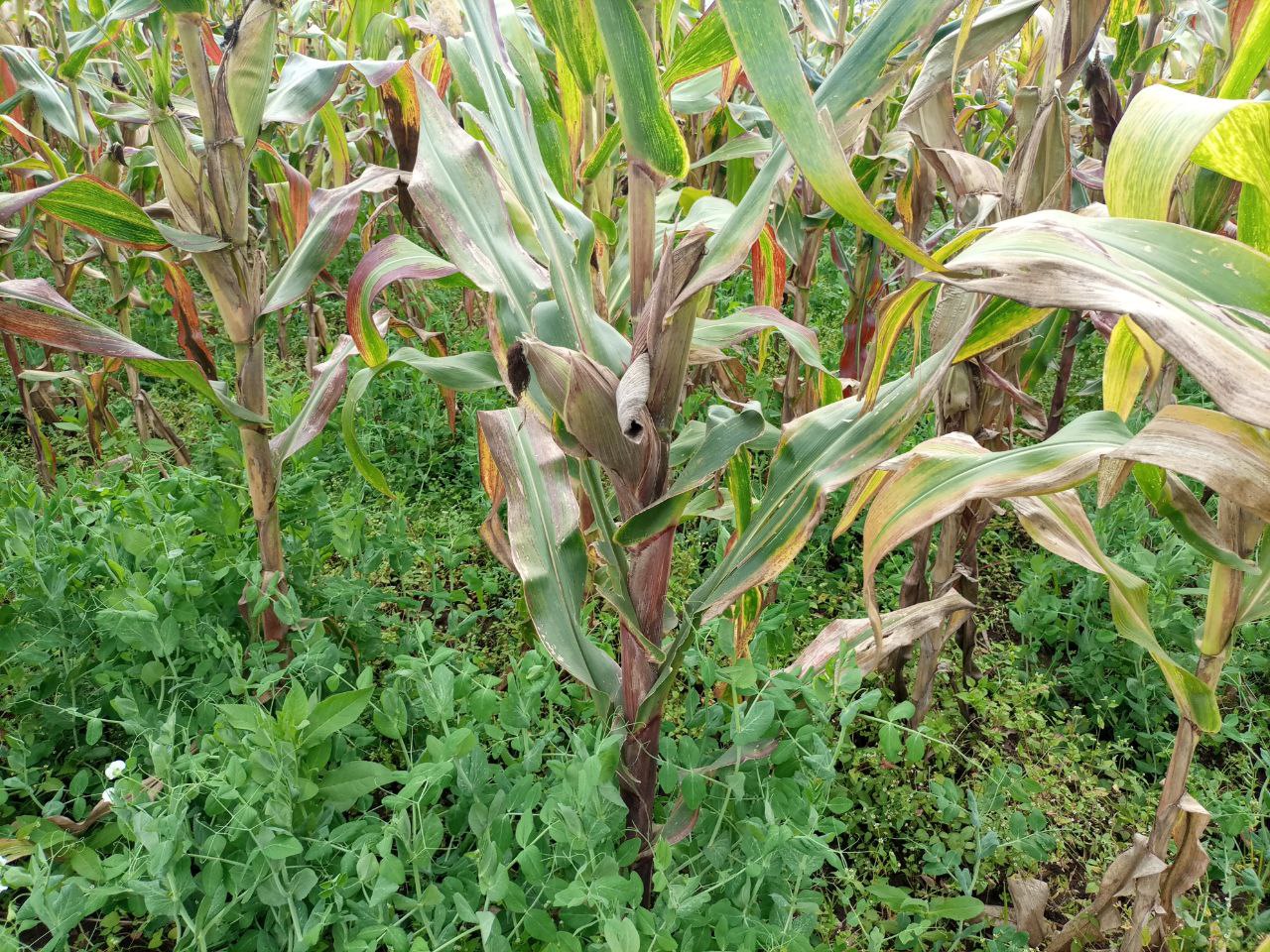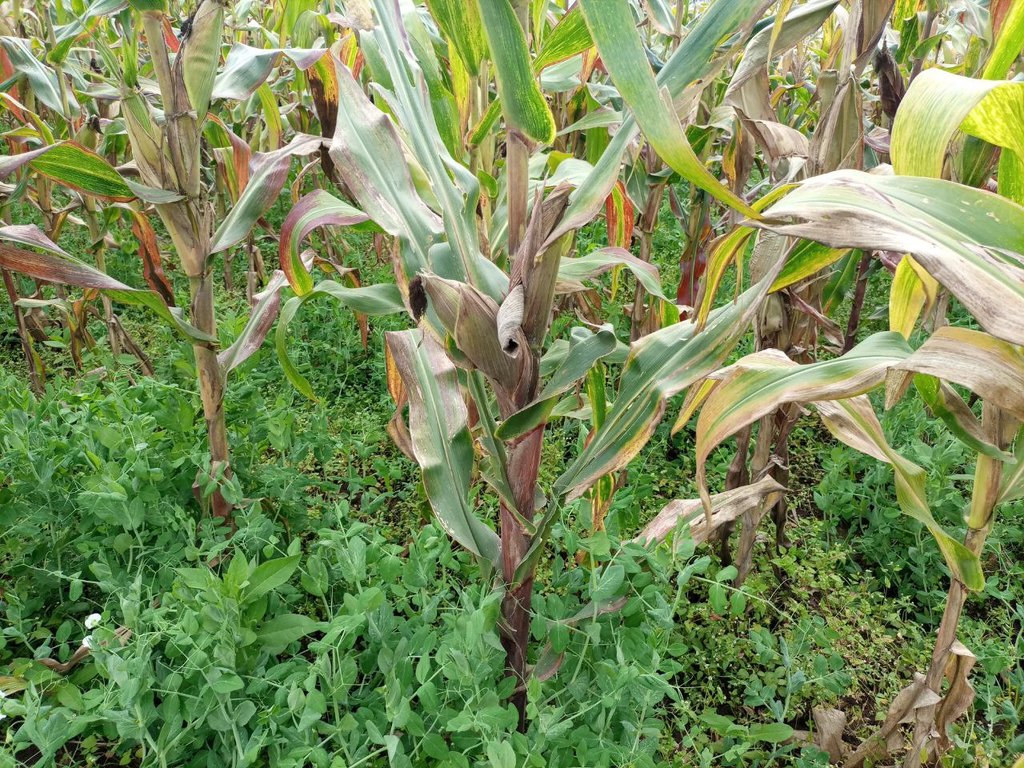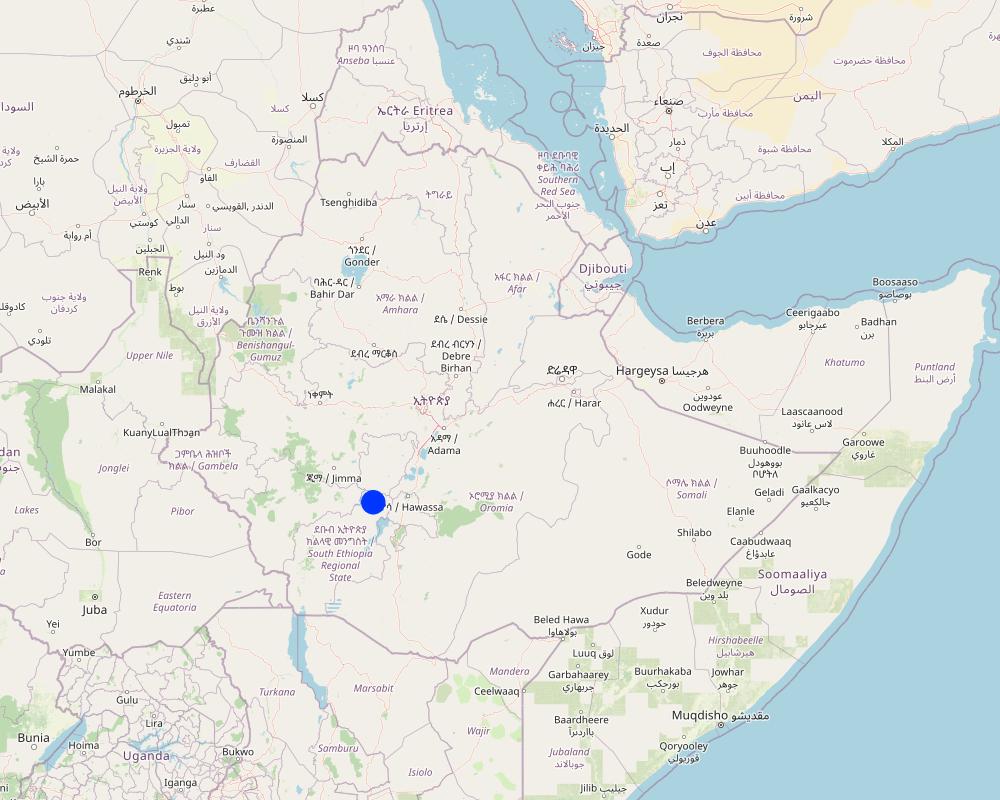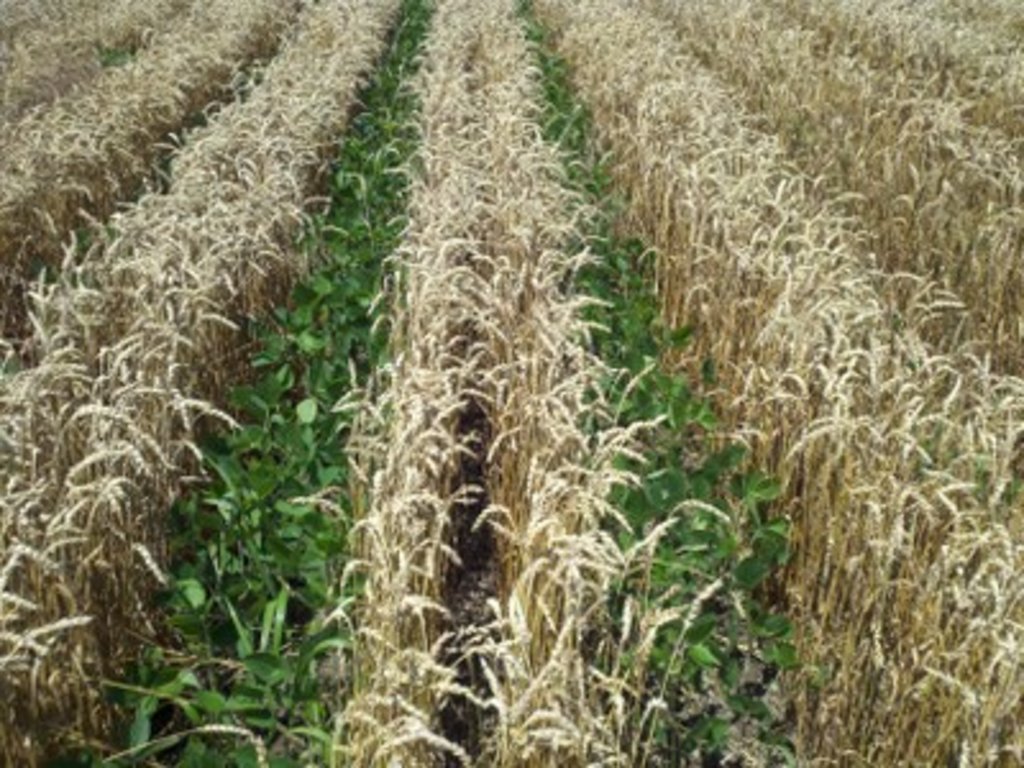Relay Intercropping [Ethiopia]
- Creation:
- Update:
- Compiler: GERBA LETA
- Editors: Julia Doldt, Kidist Yilma, Noel Templer, Tabitha Nekesa, Ahmadou Gaye, Siagbé Golli
- Reviewers: William Critchley, Rima Mekdaschi Studer, Sally Bunning
Kurcheta
technologies_6630 - Ethiopia
View sections
Expand all Collapse all1. General information
1.2 Contact details of resource persons and institutions involved in the assessment and documentation of the Technology
Key resource person(s)
land user:
Sankura Goa
Farmer
Ethiopia
Name of project which facilitated the documentation/ evaluation of the Technology (if relevant)
Soil protection and rehabilitation for food security (ProSo(i)l)Name of the institution(s) which facilitated the documentation/ evaluation of the Technology (if relevant)
CIAT International Center for Tropical Agriculture (CIAT International Center for Tropical Agriculture) - Kenya1.3 Conditions regarding the use of data documented through WOCAT
The compiler and key resource person(s) accept the conditions regarding the use of data documented through WOCAT:
Yes
1.4 Declaration on sustainability of the described Technology
Is the Technology described here problematic with regard to land degradation, so that it cannot be declared a sustainable land management technology?
No
Comments:
Intercropping is friendly to the farm. It also increases the "land equivalent ratio" of a plot of land. However, farmers note that surface compaction can be a problem under relay intercropping - because of the frequent field operations required for each of the crops at different times.
1.5 Reference to Questionnaire(s) on SLM Approaches (documented using WOCAT)
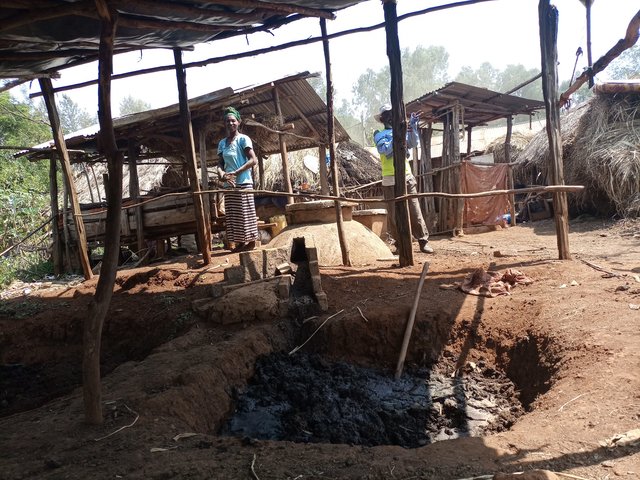
Integrated Soil Fertility Management (ISFM) [Ethiopia]
The Integrated Soil Fertility Management (ISFM) approach has been adopted under the Integrated Soil Fertility Management Project (ISFM+). It was introduced as a quick-win solution to increase both crop and biomass production through the incremental promotion of varied but complementary technology packages.
- Compiler: GERBA LETA
2. Description of the SLM Technology
2.1 Short description of the Technology
Definition of the Technology:
Intercropping is the growing of two or more crops on the same piece of land at the same time or in temporal sequence. Relay intercropping usually involves planting a legume into an established cereal crop. This farming practice has multiple benefits and is a popular among smallholders in Wolaita zone of SNNPR.
2.2 Detailed description of the Technology
Description:
Intercropping systems in Sodo Zuria of Waraza-Lasho kebele are characterized by relay intercropping. Under relay intercropping a second crop is planted alongside a growing crop, typically when it has reached its reproductive stage of growth. The practice enables efficient use of available space. In this kebele (lower administrative unit), field peas and haricot beans are commonly intercropped within maize. The seeds of these legumes are either sown in no particular pattern, or simply broadcast, under the main crop, maize. They are planted when the maize comes close to physiological maturity. Intercropping of cereals with legumes improves soil fertility through nitrogen fixation: this system extracts fewer nutrients from the soil than do monocrops. The practice also avoid risks of crop failure, improves effective use of available land, generates additional income and ensures food and nutrition security of the family farmers. Making the right choices about crops and timing of relay planting is crucial. Furthermore, good intercropping demands improved varieties of cereals and legumes. Adequate and timely labour is required also. Conventionally, the farmers till the land up to five times before planting the main crop. In relay intercropping further more land cultivation is essential to plant the companion crop.
Various researchers have reported considerably higher yields from intercropping compared with a pure stand. This can be measured through the “land equivalent ratio” which describes the relative land area required under sole cropping to produce the same yield as under intercropping. Intercropping has been regarded by many farmers as a technique that reduces risk in crop production. It improves carbon sequestration since it enhances biomass accumulation both above and below the surface of the soil. Intercropping is also a form of climate change adaptation strategy as it spreads risks and allows opportunistic use of extra moisture. However, relay intercropping can subject the land to compaction because the companion crops demand extra field operations. These include harvesting the main crops, or sometimes stripping the leaves to reduce the shading effects for the low growing companion crops. There is also extra labour required for weeding and harvesting of the intercrop.
2.3 Photos of the Technology
General remarks regarding photos:
The photo portrays relay intercropping whereby beans were planted late when the main crops nearly matured. The practice has an immense contribution to the family farmer not only in terms of improving soil fertility but also improving food and nutrition security of the family farmer.
2.4 Videos of the Technology
Comments, short description:
Videos of the technology is not documented.
2.5 Country/ region/ locations where the Technology has been applied and which are covered by this assessment
Country:
Ethiopia
Region/ State/ Province:
SNNPR
Further specification of location:
Sodo Zuria
Specify the spread of the Technology:
- evenly spread over an area
If precise area is not known, indicate approximate area covered:
- 0.1-1 km2
Is/are the technology site(s) located in a permanently protected area?
No
Map
×2.6 Date of implementation
If precise year is not known, indicate approximate date:
- more than 50 years ago (traditional)
2.7 Introduction of the Technology
Specify how the Technology was introduced:
- as part of a traditional system (> 50 years)
- through projects/ external interventions
- through agricultural extension system
Comments (type of project, etc.):
Intercropping is a common practices since over 5 decades but the distribution limited to a few farmers. The agroecology project/ISFM+ intervention stimulated its pervasive implementation.
3. Classification of the SLM Technology
3.1 Main purpose(s) of the Technology
- improve production
- conserve ecosystem
- reduce risk of disasters
- adapt to climate change/ extremes and its impacts
- create beneficial economic impact
3.2 Current land use type(s) where the Technology is applied
Land use mixed within the same land unit:
Yes

Cropland
- Annual cropping
Annual cropping - Specify crops:
- cereals - maize
- legumes and pulses - beans
Number of growing seasons per year:
- 2
Specify:
The area received Belg (short rain) and Meher (long rain with summer maximum).
Is intercropping practiced?
Yes
Is crop rotation practiced?
Yes
If yes, specify:
Rotating cereal crops with root crops.
3.3 Has land use changed due to the implementation of the Technology?
Has land use changed due to the implementation of the Technology?
- No (Continue with question 3.4)
3.4 Water supply
Water supply for the land on which the Technology is applied:
- rainfed
3.5 SLM group to which the Technology belongs
- rotational systems (crop rotation, fallows, shifting cultivation)
- integrated crop-livestock management
- integrated soil fertility management
3.6 SLM measures comprising the Technology

agronomic measures
- A2: Organic matter/ soil fertility
- A5: Seed management, improved varieties
- A6: Residue management
A6: Specify residue management:
A 6.3: collected

management measures
- M5: Control/ change of species composition
- M6: Waste management (recycling, re-use or reduce)
3.7 Main types of land degradation addressed by the Technology

soil erosion by water
- Wt: loss of topsoil/ surface erosion

chemical soil deterioration
- Cn: fertility decline and reduced organic matter content (not caused by erosion)

biological degradation
- Bc: reduction of vegetation cover
- Bl: loss of soil life
3.8 Prevention, reduction, or restoration of land degradation
Specify the goal of the Technology with regard to land degradation:
- reduce land degradation
- restore/ rehabilitate severely degraded land
4. Technical specifications, implementation activities, inputs, and costs
4.1 Technical drawing of the Technology
Technical specifications (related to technical drawing):
Soybean intercropped with wheat. Adopted from https://www.no-tillfarmer.com/articles/4084-lessons-learned-from-2014-modified-relay-intercropping.
Author:
Ohio State University
4.2 General information regarding the calculation of inputs and costs
Specify how costs and inputs were calculated:
- per Technology area
Indicate size and area unit:
4 Timad
If using a local area unit, indicate conversion factor to one hectare (e.g. 1 ha = 2.47 acres): 1 ha =:
4 Timad = 1ha
other/ national currency (specify):
Ethiopia Birr (ETB)
If relevant, indicate exchange rate from USD to local currency (e.g. 1 USD = 79.9 Brazilian Real): 1 USD =:
53.6283
Indicate average wage cost of hired labour per day:
400
4.3 Establishment activities
Comments:
We consider documentation of maintenance costs only to put in place the companion crops.
4.4 Costs and inputs needed for establishment
Comments:
As we opt to focus on the maintenance cost of the relay intercropping, establishment cost is intentionally skipped.
4.5 Maintenance/ recurrent activities
| Activity | Timing/ frequency | |
|---|---|---|
| 1. | Land preparation | Before and during planting of companion crop. |
| 2. | Planting | During the long rain for associated crop. |
| 3. | Weeding | Three weeks after emergency of companion crops seedling onwards. |
| 4. | Harvesting | At the end of harvest season. |
4.6 Costs and inputs needed for maintenance/ recurrent activities (per year)
| Specify input | Unit | Quantity | Costs per Unit | Total costs per input | % of costs borne by land users | |
|---|---|---|---|---|---|---|
| Labour | Land preparation | PDs | 8.0 | 400.0 | 3200.0 | 100.0 |
| Labour | Planting | PDs | 4.0 | 400.0 | 1600.0 | 100.0 |
| Labour | Weeding | PDs | 8.0 | 100.0 | 800.0 | 100.0 |
| Labour | Harvesting | PDs | 8.0 | 100.0 | 800.0 | 100.0 |
| Plant material | Haricot beans/field peas seeds | kg | 40.0 | 60.0 | 2400.0 | 100.0 |
| Fertilizers and biocides | NSP fertilizer | kg | 50.0 | 45.0 | 2250.0 | 100.0 |
| Total costs for maintenance of the Technology | 11050.0 | |||||
| Total costs for maintenance of the Technology in USD | 206.05 | |||||
Comments:
Almost all labor cost, seed and other inputs are covered by land users for maintaining the technology.
4.7 Most important factors affecting the costs
Describe the most determinate factors affecting the costs:
Usually, the cost is influenced by the economic crisis and high inflation rate experienced in the last few years in Ethiopia. It is also related to global fuel and fertilizer prices as well as other crises which are the potential causes.
5. Natural and human environment
5.1 Climate
Annual rainfall
- < 250 mm
- 251-500 mm
- 501-750 mm
- 751-1,000 mm
- 1,001-1,500 mm
- 1,501-2,000 mm
- 2,001-3,000 mm
- 3,001-4,000 mm
- > 4,000 mm
Specify average annual rainfall (if known), in mm:
1452.00
Specifications/ comments on rainfall:
Bimodal rainfall is intercepted in the area with a summer maximum from June to September.
Indicate the name of the reference meteorological station considered:
Sodo Center Meteorology
Agro-climatic zone
- sub-humid
High temperature is experienced from December to February.
5.2 Topography
Slopes on average:
- flat (0-2%)
- gentle (3-5%)
- moderate (6-10%)
- rolling (11-15%)
- hilly (16-30%)
- steep (31-60%)
- very steep (>60%)
Landforms:
- plateau/plains
- ridges
- mountain slopes
- hill slopes
- footslopes
- valley floors
Altitudinal zone:
- 0-100 m a.s.l.
- 101-500 m a.s.l.
- 501-1,000 m a.s.l.
- 1,001-1,500 m a.s.l.
- 1,501-2,000 m a.s.l.
- 2,001-2,500 m a.s.l.
- 2,501-3,000 m a.s.l.
- 3,001-4,000 m a.s.l.
- > 4,000 m a.s.l.
Indicate if the Technology is specifically applied in:
- not relevant
Comments and further specifications on topography:
The altitude of the place is 1,940 m above sea level.
5.3 Soils
Soil depth on average:
- very shallow (0-20 cm)
- shallow (21-50 cm)
- moderately deep (51-80 cm)
- deep (81-120 cm)
- very deep (> 120 cm)
Soil texture (topsoil):
- medium (loamy, silty)
Soil texture (> 20 cm below surface):
- medium (loamy, silty)
Topsoil organic matter:
- medium (1-3%)
If available, attach full soil description or specify the available information, e.g. soil type, soil PH/ acidity, Cation Exchange Capacity, nitrogen, salinity etc.
The SLM experts describe the soil texture as clay loam.
5.4 Water availability and quality
Ground water table:
5-50 m
Availability of surface water:
good
Water quality (untreated):
poor drinking water (treatment required)
Water quality refers to:
ground water
Is water salinity a problem?
No
Is flooding of the area occurring?
No
5.5 Biodiversity
Species diversity:
- high
Habitat diversity:
- low
5.6 Characteristics of land users applying the Technology
Sedentary or nomadic:
- Sedentary
Market orientation of production system:
- mixed (subsistence/ commercial)
Off-farm income:
- less than 10% of all income
Relative level of wealth:
- rich
Individuals or groups:
- individual/ household
Level of mechanization:
- manual work
Gender:
- men
Age of land users:
- elderly
Indicate other relevant characteristics of the land users:
The farmer piloted conservation agriculture practices. Also, the land users plant woodlots around the periphery of his farmland.
5.7 Average area of land used by land users applying the Technology
- < 0.5 ha
- 0.5-1 ha
- 1-2 ha
- 2-5 ha
- 5-15 ha
- 15-50 ha
- 50-100 ha
- 100-500 ha
- 500-1,000 ha
- 1,000-10,000 ha
- > 10,000 ha
Is this considered small-, medium- or large-scale (referring to local context)?
- small-scale
Comments:
Land users owns 3.5 hectares of land.
5.8 Land ownership, land use rights, and water use rights
Land ownership:
- state
- individual, titled
Land use rights:
- individual
Water use rights:
- open access (unorganized)
Are land use rights based on a traditional legal system?
Yes
Specify:
The land is inherited from the family line but aligned with the constitution adopted by the government that guaranty usufructs to the land.
5.9 Access to services and infrastructure
health:
- poor
- moderate
- good
education:
- poor
- moderate
- good
technical assistance:
- poor
- moderate
- good
employment (e.g. off-farm):
- poor
- moderate
- good
markets:
- poor
- moderate
- good
energy:
- poor
- moderate
- good
roads and transport:
- poor
- moderate
- good
drinking water and sanitation:
- poor
- moderate
- good
financial services:
- poor
- moderate
- good
Comments:
There is a high unemployment rate. Of course, the area is highly populated. As the site is located closer to the zonal capital they have good financial services particularly access to Bank services such as for saving.
6. Impacts and concluding statements
6.1 On-site impacts the Technology has shown
Socio-economic impacts
Production
crop production
Comments/ specify:
Increases as the technology best use the available space and surplus moisture in the soil system.
crop quality
Comments/ specify:
Increases as the arrangement allows the relay crop to enjoy the space and available residual nutrients at disposal.
product diversity
Comments/ specify:
Relay intercropping increases the number of crops harvested per unit of land in one season.
production area
land management
Comments/ specify:
Combining cereal with legumes improves land management by increasing biomass production and combining cereal with nitrogen-fixing legumes that contribute to land management.
Water availability and quality
drinking water availability
drinking water quality
Income and costs
farm income
Comments/ specify:
Combining two different types of crop on a farm diversify farm income.
diversity of income sources
economic disparities
workload
Comments/ specify:
Workload increases as it demands additional labor for land preparation, planting, weeding, and harvesting two crops grown in temporal sequences.
Socio-cultural impacts
food security/ self-sufficiency
Comments/ specify:
Relay intercropping allows ensuring the food and nutrition security of family farmers.
health situation
SLM/ land degradation knowledge
Ecological impacts
Water cycle/ runoff
water quantity
water quality
Soil
soil moisture
Comments/ specify:
Soil moisture can exhaustively be used by the companion crop.
soil cover
soil loss
soil compaction
Comments/ specify:
Frequent farm operation for two different crops increases the pressure that leads to soil compaction.
nutrient cycling/ recharge
Biodiversity: vegetation, animals
Vegetation cover
biomass/ above ground C
plant diversity
Climate and disaster risk reduction
drought impacts
emission of carbon and greenhouse gases
Comments/ specify:
Ground cover by two different crops on a temporal basis increases the absorption and storage of carbon.
micro-climate
6.2 Off-site impacts the Technology has shown
water availability
Comments/ specify:
No actual data to forecast the potential off-site impacts.
reliable and stable stream flows in dry season
impact of greenhouse gases
Comments/ specify:
Land covered by crops for extended part of a season contributes to carbon sequestration and reduction of greenhouse gases.
6.3 Exposure and sensitivity of the Technology to gradual climate change and climate-related extremes/ disasters (as perceived by land users)
Gradual climate change
Gradual climate change
| Season | increase or decrease | How does the Technology cope with it? | |
|---|---|---|---|
| annual temperature | increase | moderately | |
| annual rainfall | decrease | not well |
6.4 Cost-benefit analysis
How do the benefits compare with the maintenance/ recurrent costs (from land users' perspective)?
Short-term returns:
positive
Long-term returns:
very positive
Comments:
Maintenance cost for intercropping limited largely to labor and agricultural inputs such as seed and fertilizers.
6.5 Adoption of the Technology
- 1-10%
Of all those who have adopted the Technology, how many did so spontaneously, i.e. without receiving any material incentives/ payments?
- 0-10%
Comments:
About 6% of land users adopted the technology on their own motivation.
6.6 Adaptation
Has the Technology been modified recently to adapt to changing conditions?
No
6.7 Strengths/ advantages/ opportunities of the Technology
| Strengths/ advantages/ opportunities in the land user’s view |
|---|
| Improve family farmers diet from the perspective of food and nutrition security. |
| Generate income from the sale of companion legume crops. |
| Improve soil fertility and management of the land |
| Strengths/ advantages/ opportunities in the compiler’s or other key resource person’s view |
|---|
| Improve effective resource utilization such as land, labor, and inputs. |
| Insure against total crop failure under unfavorable weather conditions, and pest outbreaks. |
| Improve and maintain soil fertility as the combination is mostly cereal with legumes. |
| Increase total biomass and crop production per unit of land. |
| Pest levels are often lowered in intercrops, as the diversity of plants hampers the movement of certain pest insects and in some cases encourages beneficial insect populations. |
| Reduce soil erosion, lower soil surface evaporation & reduce weed infestation. |
6.8 Weaknesses/ disadvantages/ risks of the Technology and ways of overcoming them
| Weaknesses/ disadvantages/ risks in the land user’s view | How can they be overcome? |
|---|---|
| Demand more labor. | Overlay planting season, and promote row intercropping to simplify the management practices. |
| Relay intercropping triggers soil compaction, | Promote row intercropping for effective utilization of space and reduction of soil compaction. |
| Shortage of best fitting varieties of legume crops for relay intercropping. | Facilitate and improve land users access to suitable companion crops from the nearby research institutes. |
| Weaknesses/ disadvantages/ risks in the compiler’s or other key resource person’s view | How can they be overcome? |
|---|---|
| It is time-consuming as it requires more attention and thus increases intensive management. | Promote row intercropping and overlay planting season to avoid giving separate management practices. |
| There is reduced efficiency in planting, weeding and harvesting which may add to the labor costs of these operations, especially if the practice is at a larger scale. | Plant the main and companion crops simultaneously and apply optimum management practices. |
7. References and links
7.1 Methods/ sources of information
- field visits, field surveys
Five persons.
- interviews with land users
Only the land user.
- interviews with SLM specialists/ experts
Three experts.
When were the data compiled (in the field)?
17/01/2023
7.2 References to available publications
Title, author, year, ISBN:
Guidelines for Intercropping. Mohler, C. L. and Stoner, K. A. 2009.
Available from where? Costs?
EBook for $24 (https://www.sare.org/publications/crop-rotation-on-organic-farms/guidelines-for-intercropping/)
Title, author, year, ISBN:
Raza, M.A. et al. 2019. Growth and development of soybean under changing light environments in relay intercropping system. DOI: 10.7717/Peerji.7262.
Available from where? Costs?
Free online from Research gate
7.3 Links to relevant online information
Title/ description:
Intercropping: What it is, what it isn't and why we do it.
URL:
https://www.permaculturenews.or/2016/08/12
Title/ description:
Intercropping Agriculture System
URL:
https://fscluster.org/gaziantep
Title/ description:
Intercropping: Ergonomic and Efficient Farming
URL:
https://eos.com/blog/intercropping/
7.4 General comments
Specifications under 3.6 such as tillage system, and reside management are not well aligned with the pdf version. So, it is difficult to make choices.
Links and modules
Expand all Collapse allLinks

Integrated Soil Fertility Management (ISFM) [Ethiopia]
The Integrated Soil Fertility Management (ISFM) approach has been adopted under the Integrated Soil Fertility Management Project (ISFM+). It was introduced as a quick-win solution to increase both crop and biomass production through the incremental promotion of varied but complementary technology packages.
- Compiler: GERBA LETA
Modules
No modules


